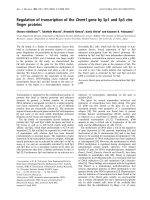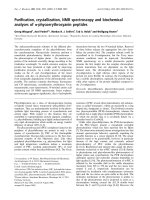Báo cáo y học: "Hyperglycemia may alter cytokine production and phagocytosis by means other than hyperosmotic stress" pdf
Bạn đang xem bản rút gọn của tài liệu. Xem và tải ngay bản đầy đủ của tài liệu tại đây (39.05 KB, 2 trang )
Page 1 of 2
(page number not for citation purposes)
Available online />Abstract
In the previous issue of Critical Care, Otto and colleagues used in
vitro studies to explore the theory that immunomodulation, by
correction of hyperglycemia, may be a contributing factor to the
reported efficacy of intensive insulin therapy (IIT) in critically ill
patients. They suggested that hyperglycemia via hyperosmolarity at
supra-physiological levels potentiates the production of cytokines
by peripheral blood mononuclear cells in response to lipopoly-
saccharide (LPS) stimulation and that it also reduces the
responses of phagocytosis and oxidative burst in human granulo-
cytes. The efficacy of IIT, they concluded, may be partially due to
the correction of hyperosmolality. Other studies, however, have
suggested that immunological responses to LPS in the presence
of hyperglycemia are mediated by a mechanism other than
hyperosmolality.
In the previous issue of Critical Care, Otto and colleagues [1]
used in vitro studies to explore the theory that immunological
activation induced by hyperglycemia is the result of
hyperosmololaity. There is, in fact, a growing body of literature
on osmotic regulation of cell function with possible
implications on clinical outcomes [2]. At the forefront of this
research is the use of hypertonic solutions to attenuate
inflammation and immunosuppression following traumatic
injury or sepsis [3-5]. It is widely known that administration of
hypertonic solutions promotes a more balanced inflammatory
response that may improve outcomes.
Otto and colleagues [1] suggest that immunomodulation, by
correction of hyperglycemia, is a contributing factor to the
efficacy of intensive insulin therapy (IIT) in critically ill patients,
as proposed by Van den Berghe and colleagues [6]. Their ex
vivo studies suggested that hyperglycemia, via hyperosmo-
larity, potentiates the production of cytokines by peripheral
blood mononuclear cells (PBMCs) in response to lipopoly-
saccharide (LPS) stimulation. Furthermore, they examined the
effect of hyperglycemia on phagocytosis and oxidative burst
in human granulocytes and found the responses reduced
with hyperglycemia. They postulated that the efficacy of IIT
may be due, at least in part, to the correction of hyper-
osmolality induced by the lowering of blood glucose in
response to insulin administration.
When assessing the effect of various solutions, there must be
a clear distinction between the osmolality and tonicity.
Osmolality and osmolarity refer to the property of a solution in
the absence of reference to a membrane. Tonicity, on the
other hand, is in reference to a membrane and is equal to the
molecular concentrations of the solutes that exert an osmotic
force across the membrane. Tonicity is dependent on the
permeability of the solutes across the membrane. Thus, a
highly permeable solute, such as glucose, does not exert a
high tonicity. The majority of solutes that have been demon-
strated to attenuate immunological response to injury or
infection have been hypertonic, specifically, sodium chloride.
Otto and colleagues tried to address the issue of osmolality
and tonicity by contrasting responses to hyperglycemia to
those of an equally hyperosmotic solution, mannitol. Mannitol
is a hypertonic solution, whereas glucose is usually con-
sidered isotonic. In response to LPS stimulation, hyper-
glycemia enhanced the production of interleukin (IL)-6 and
IL-1β; however, mannitol produced no significant difference
(compared with control). Otto and colleagues further
investigated the hypertonicity of hyperglycemia by supple-
menting the incubation media with insulin to facilitate cellular
uptake of glucose, resulting in a reduction in tonicity. The
authors claimed that the inclusion of insulin partially reversed
the production of cytokines; however, the only significant
decrease was for IL-1β at the highest dose of insulin and
glucose. The inability of mannitol to induce an increased
Commentary
Hyperglycemia may alter cytokine production and phagocytosis
by means other than hyperosmotic stress
Charles E Wade
US Army Institute for Surgical Research, 3400 Rawley E. Chambers Avenue, Fort Sam Houston, TX 78234, USA
Corresponding author: Charles E Wade,
Published: 9 October 2008 Critical Care 2008, 12:182 (doi:10.1186/cc7012)
This article is online at />© 2008 BioMed Central Ltd
See related research by Otto et al., />IIT = intensive insulin therapy; IL = interleukin; LPS = lipopolysaccharide; PBMC = peripheral blood mononuclear cell.
Page 2 of 2
(page number not for citation purposes)
Critical Care Vol 12 No 5 Wade
cytokine response and the absence of a consistent attenu-
ation of the response with insulin suggest that factors other
than hyperosmolality and hypertonicity are involved in the
potentiation of cytokine responses by hyperglycemia.
Plasma osmolality is the sum of concentrations of the various
solutes in a solution. Normal plasma osmolality ranges from
280 to 305 mOsm/kg. Otto and colleagues increased the
glucose concentrations from 100 mg/dL to 250, 500, and
1,000 mg/dL. Theoretically, this would increase plasma
osmolality by 8, 22, and 50 mOsm/kg, respectively. But as
noted above, changes in cytokines were mostly observed at
only the highest glucose level, representing a supra-
physiological plasma glucose concentration and thus
osmolality. Alterations in phagocytosis and oxidative burst in
human granulocytes were determined at only the 500 mg/dL
glucose level, an upper clinical limit. Similar supra-physio-
logical increases in hyperosmolality have been used in the
evaluation of other solutes. Thus, while these ex vivo findings
are interesting, when the dose levels are considered clinical
application may be limited.
The profound effect of hypertonic saline on immunological
responses both in vitro and in vivo is extensively explored in
the literature [2]. Exposure to hypertonic saline reduces
PBMC function in response to activation of the p38 MAPK
(mitogen-activated protein kinase). This reduction in function
correlates with a decrease in inflammation and tissue damage
in vivo. In contrast, Otto and colleagues demonstrated an
increase in activity of PBMC function with exposure to
hyperglycemia, suggesting an alternate function other than
hyperosmolality.
In addition, Otto and colleagues found hyperglycemia to
reduce phagocytosis and oxidative burst in human granulo-
cytes. This response was similar to that observed acutely with
hypertonic mannitol or saline [7]. There are various interpre-
tations as to the advantages or disadvantages of attenuation
of these responses. In the acute phase, this reduction may, in
fact, attenuate tissue damage. However, it may lead later to
increased susceptibility to infection.
Otto and colleagues reported enhancement of immunological
responses to LPS in the presence of hyperglycemia. This
response does not appear to be mediated by hyperosmolality
as postulated by the authors but by another mechanism. Their
study emphasizes the absence of information able to explain
the underlying mechanisms responsible for the purported
improvements in clinical outcomes of critically ill patients
following correction of hyperglycemia by IIT.
Competing interests
The author declares that he has no competing interests.
References
1. Otto NM, Schindler R, Lun A, Boenisch O, Frei U, Oppert M:
Hyperosmotic stress enhances cytokine production and
decreases phagocytosis in vitro. Crit Care 2008, 12:R107.
2. Shukla A, Hashiguchi N, Chen Y, Coimbra R, Hoyt DB, Junger
WG: Osmotic regulation of cell function and possible clinical
applications. Shock 2004, 21:391-400.
3. Bulger EM, Cuschieri J, Warner K, Maier RV: Hypertonic resusci-
tation modulates the inflammatory response in patients with
traumatic hemorrhagic shock. Ann Surg 2007, 245:635-641.
4. Oliveira RP, Velasco I, Soriano F, Friedman G: Clinical review:
hypertonic saline resuscitation in sepsis. Crit Care 2002, 6:
418-423.
5. Rizoli SB, Rhind SG, Shek PN, Inaba K, Filips D, Tien H, Brenne-
man F, Rotstein O: The immunomodulatory effects of hyper-
tonic saline resuscitation in patients sustaining traumatic
hemorrhagic shock: a randomized, controlled, double-blinded
trial. Ann Surg 2006, 243:47-57.
6. Van den Berghe G, Wilmer A, Milants I, Wouters PJ, Bouckaert B,
Bruyninckx F, Bouillon R, Schetz M: Intensive insulin therapy in
mixed medical/surgical intensive care units: benefit versus
harm. Diabetes 2006, 55:3151-3159.
7. Hashiguchi N, Lum L, Romeril E, Chen Y, Yip L, Hoyt DB, Junger
WG: Hypertonic saline resuscitation: efficacy may require
early treatment in severely injured patients. J Trauma 2007,
62:299-306.









